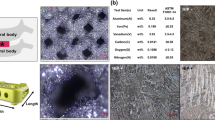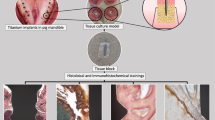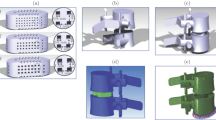Abstract
Recent advances in the additive manufacturing technology now enable fused filament fabrication of polyetheretherketone (PEEK). A standardized lumbar fusion cage design was 3D printed with different speeds of the printhead nozzle to investigate whether 3D-printed PEEK cages exhibit sufficient material properties for lumbar fusion applications. It was observed that the compressive and shear strength of the 3D-printed cages were 63–71% of the machined cages, whereas the torsion strength was 92%. The printing speed is an important printing parameter for 3D-printed PEEK, which resulted in up to 20% porosity at the highest speed of 3000 mm/min, leading to reduced cage strength. Printing speeds below 1500 mm/min can be chosen as the optimal printing speed for this printer to reduce the printing time while maintaining strength. The crystallinity of printed PEEK did not differ significantly from the as-machined PEEK cages from extruded rods, indicating that the processing provides similar microstructure.








Similar content being viewed by others
References
P. Tack, J. Victor, P. Gemmel, and L. Annemans: 3D-printing techniques in a medical setting: A systematic literature review. Biomed. Eng. Online 15, 115 (2016).
A.E. Eltorai, E. Nguyen, and A.H. Daniels: Three-dimensional printing in orthopedic surgery. Orthopedics 38, 684 (2015).
D.M. Gibbs, M. Vaezi, S. Yang, and R.O. Oreffo: Hope versus hype: What can additive manufacturing realistically offer trauma and orthopedic surgery? Regener. Med. 9, 535 (2014).
N. Martelli, C. Serrano, H. van den Brink, J. Pineau, P. Prognon, I. Borget, and S. El Batti: Advantages and disadvantages of 3-dimensional printing in surgery: A systematic review. Surgery 159, 1485 (2016).
E. Provaggi, J.J.H. Leong, and D.M. Kalaskar: Applications of 3D printing in the management of severe spinal conditions. Proc. Inst. Mech. Eng., Part H 231, 471 (2017).
C.L. Ventola: Medical applications for 3D printing: Current and projected uses. P&T 39, 704 (2014).
D. Janusz, S. Konstanty, G. Roman, and M. Adrian: Rapid prototyping in the intervertebral implant design process. Rapid Prototyp. J. 21, 735 (2015).
N. de Beer and A. van der Merwe: Patient-specific intervertebral disc implants using rapid manufacturing technology. Rapid Prototyp. J. 19, 126 (2013).
J.O. Figueroa-Cavazos, E. Flores-Villalba, J.A. Diaz-Elizondo, O. Martinez-Romero, C.A. Rodriguez, and H.R. Siller: Design concepts of polycarbonate-based intervertebral lumbar cages: Finite element analysis and compression testing. Appl. Bionics Biomechanics 2016, 7149182 (2016).
T. Serra, C. Capelli, R. Toumpaniari, I.R. Orriss, J.J. Leong, K. Dalgarno, and D.M. Kalaskar: Design and fabrication of 3D-printed anatomically shaped lumbar cage for intervertebral disc (IVD) degeneration treatment. Biofabrication 8, 035001 (2016).
O. Figueroa, C.A. Rodríguez, H.R. Siller, O. Martinez-Romero, E. Flores-Villalba, J. Díaz-Elizondo, and R. Ramírez: Lumbar cage design concepts based on additive manufacturing. In High Value Manufacturing: Advanced Research in Virtual and Rapid Prototyping, P.H.A. Silva Bártolo, A.C.S. de Lemos, and A.M.H. Pereira, eds. (CRC Press, New York, USA, 2013); ch. 102.
K.C. McGilvray, E.I. Waldorff, J. Easley, H.B. Seim, N. Zhang, R.J. Linovitz, J.T. Ryaby, and C.M. Puttlitz: Evaluation of a polyetheretherketone (PEEK) titanium composite interbody spacer in an ovine lumbar interbody fusion model: Biomechanical, microcomputed tomographic, and histologic analyses. Spine J. 17, 1907–1916 (2017).
K. Asil and C. Yaldiz: Retrospective comparison of radiological and clinical outcomes of PLIF and TLIF techniques in patients who underwent lumbar spinal posterior stabilization. Medicine 95, (2016).
P.J.d.S. Bartolo, A.C.S.d. Lemos, A.M.H. Pereira, A.J.D.S. Mateus, C. Ramos, C.D. Santos, D. Oliveira, E. Pinto, F. Craveiro, H.M.C.d.R.T.G. Bartolo, H.d.A. Almeida, I. Sousa, J.M. Matias, L. Durao, M. Gaspar, N.M.F. Alves, P. Carreira, T. Ferreira, and T. Marques: High Value Manufacturing: Advanced Research in Virtual and Rapid Prototyping: Proceedings of the 6th International Conference on Advanced Research in Leiria, Portugal, 1–5 October, 2013 (CRC Press, Inc., Leira, Portugal, 2013).
S. Vadapalli, K. Sairyo, V.K. Goel, M. Robon, A. Biyani, A. Khandha, and N.A. Ebraheim: Biomechanical rationale for using polyetheretherketone (PEEK) spacers for lumbar interbody fusion—A finite element study. Spine 31, E992 (2006).
J.W. Duncan and R.A. Bailey: An analysis of fusion cage migration in unilateral and bilateral fixation with transforaminal lumbar interbody fusion. Eur. Spine J. 22, 439 (2013).
M. Schmidt, D. Pohle, and T. Rechtenwald: Selective laser sintering of PEEK. CIRP Ann. 56, 205 (2007).
S. Berretta, K.E. Evans, and O. Ghita: Processability of PEEK, a new polymer for high temperature laser sintering (HT-LS). Eur. Polym. J. 68 (Suppl. C), 243 (2015).
W.Z. Wu, P. Geng, J. Zhao, Y. Zhang, D.W. Rosen, and H.B. Zhang: Manufacture and thermal deformation analysis of semicrystalline polymer polyether ether ketone by 3D printing. Mater. Res. Innovations 18 (Suppl. 5), S5 (2014).
M. Vaezi and S. Yang: Extrusion-based additive manufacturing of PEEK for biomedical applications. Virtual Phys. Prototyp. 10, 123 (2015).
K.M. Rahman, T. Letcher, and R. Reese: Mechanical properties of additively manufactured PEEK components using fused filament fabrication. In ASME 2015 International Mechanical Engineering Congress and Exposition Volume 2A: Advanced Manufacturing (Houston, Texas, 2015); p. 57359.
G. Cicala, A. Latteri, B. Del Curto, A. Lo Russo, G. Recca, and S. Fare: Engineering thermoplastics for additive manufacturing: A critical perspective with experimental evidence to support functional applications. J. Appl. Biomater. Funct. Mater. 15, (2017). doi: https://doi.org/10.5301/jabfm.5000343.
S.M. Kurtz, ed.: Chapter 2-synthesis and processing of PEEK for surgical implants. In PEEK Biomaterials Handbook (William Andrew Publishing, Oxford, U.K., 2012); p. 9.
S.M. Green and J. Schlegel: A Polyaryletherketone Biomaterial for Use in Medical Implant Applications (Rapra Technology Limited, Shawbury, Brussels, U.K., 2001); pp. 1–7.
Research Report: Interlaboratory Study to Establish Precision Statements for ASTM F2077 (ASTM International, West Conshohocken, Pennsylvania, 2014); pp. F04–F1014.
ASTM F2077-17: Test Methods for Intervertebral Body Fusion Devices (ASTM International, West Conshohocken, Pennsylvania, 2017).
ISO/IEC 17025:2005: General Requirements for the Competence of Testing and Calibration Laboratories International Organization for Standardization (International Organization for Standardization, Geneva, Switzerland, 2017).
T. Hildebrand and P. Rüegsegger: A new method for the model-independent assessment of thickness in three-dimensional images. J. Microsc. 185, 67 (1997).
ASTM F2778-09(2015): Standard Test Method for Measurement of Percent Crystallinity of Polyetheretherketone (PEEK) Polymers by Means of Specular Reflectance Fourier Transform Infrared Spectroscopy (R-FTIR) (ASTM International, West Conshohocken, Pennsylvania, 2015). Available at: https://doi.org/10.1520/F2778-09R15.
Victrex: victrex_tds_450g, Lancashire, U.K., 2018.
A.A. White and M.M. Panjabi: Clinical Biomechanics of the Spine (Lippincott, Philadelphia, Pennsylvania, 1978).
T.M. Keaveny and J.M. Buckley: Chapter 4-biomechanics of vertebral bone. In Spine Technology Handbook, S.M. Kurtz and A.A. Edidin, eds. (Academic Press, Burlington, Massachusetts, 2006); p. 63.
H.J. Wilke, P. Neef, M. Caimi, T. Hoogland, and L.E. Claes: New in vivo measurements of pressures in the intervertebral disc in daily life. Spine 24, 755 (1999).
M. Melkerson, J. Kirkpatrick, and S. Griffith: Spinal Implants: Are we Evaluating them Appropriately? (ASTM International, West Conshohocken, Pennsylvania, 2003).
R.K. Chen, T.T. Lo, L. Chen, and A.J. Shih: Nano-CT characterization of structural voids and air bubbles in fused deposition modeling for additive manufacturing. In ASME 2015 International Manufacturing Science and Engineering Conference Volume 1: Processing (Charlotte, North Carolina, 2015).
M. Rybachuk, C. Alice Mauger, T. Fiedler, and A. Öchsner: Anisotropic mechanical properties of fused deposition modeled parts fabricated by using acrylonitrile butadiene styrene polymer. J. Polym. Eng., 37, 699 (2017).
A. Sung-Hoon, M. Michael, O. Dan, R. Shad, and K.W. Paul: Anisotropic material properties of fused deposition modeling ABS. Rapid Prototyp. J. 8, 248 (2002).
M.C. Sobieraj and C.M. Rimnac: Chapter 5-fracture, fatigue, and notch behavior of PEEK. In PEEK Biomaterials Handbook, S.M. Kurtz, ed. (William Andrew Publishing, Oxford, U.K., 2012); p. 61.
D. Jaekel, F.J. Medel, and S.M. Kurtz: Validation of crystallinity measurements of medical grade PEEK using specular reflectance FTIR-microscopy. In Annual Technical Conference—ANTEC, Conference Proceedings, Vol. 5, 2019; pp. 2511–2516.
D.J. Jaekel, D.W. MacDonald, and S.M. Kurtz: Characterization of PEEK biomaterials using the small punch test. J. Mech. Behav. Biomed. Mater. 4, 1275 (2011).
ACKNOWLEDGMENTS
This study was supported by NIH-R01 AR069119. We would like to thank Invibio for donating the medical grade PEEK derived filament and extruded rod stock used in the experiment. We would also like to thank Apium for their helpful advice and fruitful discussions.
Author information
Authors and Affiliations
Corresponding author
Supplementary Material
Rights and permissions
About this article
Cite this article
Basgul, C., Yu, T., MacDonald, D.W. et al. Structure–property relationships for 3D-printed PEEK intervertebral lumbar cages produced using fused filament fabrication. Journal of Materials Research 33, 2040–2051 (2018). https://doi.org/10.1557/jmr.2018.178
Received:
Accepted:
Published:
Issue Date:
DOI: https://doi.org/10.1557/jmr.2018.178




